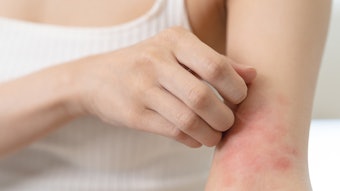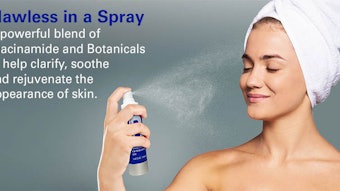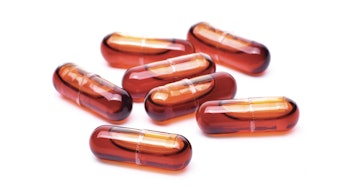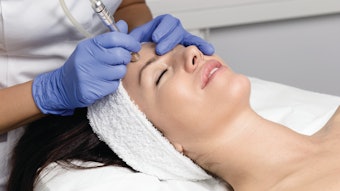
Hyperpigmentation is a stubborn condition that affects millions of people worldwide. There are various causes of hyperpigmentation including sun exposure, hormonal fluctuations and inflammation. The pigment presents differently depending on the cause. Sun-induced pigmentation presents small spots on the skin seen in areas commonly exposed to the sun, the forehead, upper cheeks and nose. Melasma is defined by dark patches on the skin particularly on the upper lip, forehead and cheeks.
Log in to view the full article
Hyperpigmentation is a stubborn condition that affects millions of people worldwide. There are various causes of hyperpigmentation including sun exposure, hormonal fluctuations and inflammation. The pigment presents differently depending on the cause. Sun-induced pigmentation presents small spots on the skin seen in areas commonly exposed to the sun, the forehead, upper cheeks and nose. Melasma is defined by dark patches on the skin particularly on the upper lip, forehead and cheeks.
Melasma is mainly triggered by hormones, but is exacerbated by external influences including light and heat. Post-inflammatory pigmentation can be apparent when there is inflammation, it often looks like a small dark patch surrounded by red or purple. There are several treatment options for hyperpigmentation making it difficult to determine the course of action. Educating yourself on the science behind targeted ingredients and how they work will help you when treating pigmentation.
Melanogenesis 101
To understand how ingredients for hyperpigmentation work, you need to first be knowledgeable on the melanogenesis process. Melanogenesis determines the color of our skin, hair and eyes, but is much more than just coloring. Melanogenesis is a complex symphony of cells, enzymes and molecules working together to protect us and maintain our overall health. Skin color is primarily based on the amount, quality and distribution of melanin. The number of melanocytes, or pigment-producing cells, is consistent in human skin regardless of skin color. In the basal cell layer of the epidermis, there is about one melanocyte for every 30 to 40 keratinocytes.
The melanogenesis process is regulated by internal factors including hormone signals, genetics and cytokines. External factors including sun exposure, pollution or medications can increase melanogenesis leading to hyperpigmentation disorders.
Melanogenesis Causes
Melanogenesis begins when there is a threat to the skin like UV radiation, hormone changes or inflammation. The keratinocyte releases melanocyte- stimulating hormone (MSH), which binds to a receptor on the surface of the melanocyte. The activated receptors turn on tyrosinase, an enzyme that is a key player in the production of melanin. Within the melanocyte, tyrosinase coverts tyrosine, an amino acid, into L-dihydroxyphenylalanine or L-DOPA. L-DOPA goes through further oxidation by tyrosinase to form dopaquinone, leading to melanin production.
The melanin produced can be eumelanin or pheomelanin. Eumelanin produces brown, black pigments while pheomelanin contributes to red and yellow tones, seen on skin type Fitzpatrick I. The pigment produced then gets packaged into melanosomes, specialized organelles that enclose the melanin. The melanosomes are transported to the keratinocytes through the dendrites, which are the extensions or arms of the melanocyte. Melanosomes are arranged to protect the nucleus from incoming threats. There are several ways to control the over-production of pigment, but consistent use of topical products is a necessity to get results.
Related: 2024 Hyperpigmentation Care Trends, Technology and Products
1. Niacinamide
Niacinamide, also known as vitamin B3, has gained attention for its multiple uses including brightening the skin. It has been shown to inhibit the transfer of melanosomes from the melanocyte to the keratinocyte. Interrupting this process reduces the amount of melanin reaching the skin, resulting in skin lightening. Niacinamide is also a tyrosinase-inhibitor, meaning it interferes with the enzyme that starts the melanogenesis process.
This ingredient is most known for improving the skin’s barrier. It increases the production of ceramides, which are essential lipids that maintain hydration and protection, making the skin more resilient to external stressors. Strengthening the barrier will improve the overall health of the skin which is needed to keep pigment under control. Niacinamide has antioxidant properties, which protect the skin from oxidative stress that can exacerbate pigmentation while also reducing inflammatory mediators in the skin to lessen inflammation.
2. Vitamin C
Vitamin C or ascorbic acid is well-known as a potent antioxidant. Its antioxidant properties are what make it work so well against hyperpigmentation; melanogenesis is an oxidative process. First, it is a natural sun protectant, as it neutralizes free radicals created by UV exposure that trigger pigment production. Vitamin C, like many other lighteners, also works as a tyrosinase inhibitor slowing down the initial step of pigment production.
Another way it reduces pigmentation is by reversing dopaquinone back to L-dopa, due to its superior antioxidant content. Besides brightening, vitamin C improves skin structure by promoting collagen and elastin production. Other forms of vitamin C have varying properties. It is an essential nutrient for the skin that should be a part of most daily regimens for photo-protection and to help repair existing damage.
3. Retinoids
Retinoids are derivatives of vitamin A that are widely used in skin care for their anti-aging and skin-renewing properties. In addition to their ability to stimulate collagen production and improve skin texture, retinoids have been shown to be effective in managing hyperpigmentation. Retinoids are known as skin normalizers; they normalize healthy functions of skin. They help to control the over production of melanin by regulating cell signaling. Another way in which they work is by promoting cell turnover; shedding hyperpigmented cells and promoting the growth of new, evenly pigmented cells. Retinoids also control melanin production by reducing tyrosinase activity. This is another ingredient that can provide benefits to almost all skin types.
4. Hydroquinone
Hydroquinone is one of the most widely studied and effective ingredients for treating hyperpigmentation. It functions primarily by inhibiting the activity of tyrosinase, the enzyme responsible for starting the production of melanin. It also interferes with the oxidation that turns L-DOPA to dopaquinone, forming pigment. There are some potential risks with the use of hydroquinone. It can irritate sensitive skin, so use of this ingredient in high concentrations is not recommended.
Potential carcinogenic properties have caused this ingredient to be banned in Europe and other countries. There is also a condition called exogenous ochronosis, where the skin develops a blue-black pigmentation and can result in thickening and hardening of the skin. This is most often due to prolonged use at high concentrations. The over-use of hydroquinone can also cause pigment bounce-back, where the pigment returns darker than before. The benefits of using this ingredient should be weighed against the possible risks.
5. Tranexamic Acid
Tranexamic acid is a synthetic derivative of the amino acid lysine that has been used orally to treat conditions such as heavy menstrual bleeding and melasma. More recently, topical formulations of tranexamic acid have emerged as promising treatments for hyperpigmentation. Tranexamic acid works differently than most other lightening agents. It functions by inhibiting the production of plasmin, an enzyme involved in the breakdown of fibrin in blood clots. Plasmin activation has been linked to the production of melanin, particularly in response to UV exposure and inflammation.
Tranexamic acid is anti-inflammatory, also preventing the activation of melanocytes. It has also been shown to improve texture, promote collagen synthesis, and increase microcirculation making it a great option for those concerned with signs of aging as well.
6. Kojic Acid
Kojic acid is a naturally occurring compound derived from various fungi species. Similar to other lighteners, kojic acid inhibits tyrosinase activity, thereby reducing melanin production. It also exhibits antioxidant properties, which help protect the skin from oxidative stress and prevent further pigmentation. Kojic acid has mild exfoliating properties; it sheds pigmented cells revealing a more even skin tone. Studies have shown that kojic acid can effectively lighten hyperpigmented areas when used consistently.
7. Arbutin
Arbutin is one of the most widely used skin lighteners worldwide. It is a naturally occurring compound found in the dried leaves of various plants including bearberry, blueberry and cranberry. Arbutin, like the other lighteners, is a tyrosinase inhibitor. It also interferes with the oxidation of L-DOPA to dopaquinone, which is where the melanin production takes place. There are some studies that suggest arbutin also fades existing pigmentation by breaking down melanosomes. It has antioxidant and anti-inflammatory properties to protect the skin and pairs well with vitamin C.
8. Azelaic Acid
Azelaic acid is a dicarboxylic acid naturally found in wheat, rye, and barley. It controls hyperpigmentation through multiple mechanisms. First, azelaic acid is anti-inflammatory, which could help prevent pigment associated with inflammation. It is also a tyrosinase inhibitor, reducing melanin production. Azelaic acid is particularly beneficial for those with acne-related hyperpigmentation due to its antimicrobial effects that help control acne breakouts.
Ingredient Power
The science behind ingredients for hyperpigmentation is complex, with various ingredients targeting different aspects of melanin production and skin pigmentation. From tyrosinase inhibitors to antioxidants and exfoliating agents, these ingredients offer a range of options for those looking to address hyperpigmentation and achieve a more even complexion. This is just a brief list of the many beneficial pigment lightening ingredients available.
When recommending products to those with hyperpigmentation, it is important that they are on a home regimen consisting of vitamin C, a retinoid, a combination of lighteners and sunscreen. When incorporated into a comprehensive skin care regimen and used consistently over time, these ingredients can help improve the appearance of hyperpigmented areas and promote overall skin health and radiance.
Additional Resources:
- https://pubmed.ncbi.nlm.nih.gov/19608057/
- https://academicstrive.com/PSARJ/PSARJ180020.pdf
- https://pubmed.ncbi.nlm.nih.gov/32720446/
- https://pubmed.ncbi.nlm.nih.gov/23723597/
- https://www.fernro.com/product/skin-care-ingredients-epub/
Terri Wojak is a highly sought-after professional with 30 years of experience in the aesthetic industry. She is a respected authority on skin care in a medical setting, education and business development on multiple levels. Terri is an international speaker and has built over 50 individual courses based on skin care, and more than 100 articles by Wojak have appeared in a multitude of industry magazines. She has also published two books, “Aesthetics Exposed: Mastering Skin Care in a Medical Setting & Beyond” and “Mastering Medical Esthetics.” Terri now runs her own education company, Aesthetics Exposed Education.










